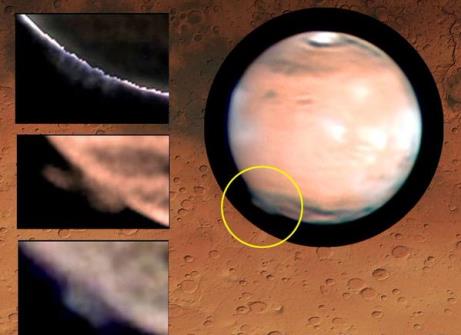The bright flares have now died away, but they were spotted on two occasions – lasting for 10 days each time – by amateur astronomers in 2012. The dusty plumes were seen rising to altitudes of 155 miles (250km) and spread out over a region measuring 300-600 miles wide.
Scientists have captured plumes erupting from Mars before by the Hubble Telescope and on databases of amateur images, but none of them reached such heights – the maximum previously recorded was 62 miles.
“At about 250 km, the division between the atmosphere and outer space is very thin, so the reported plums are extremely unexpected,” said Agustin Sanchez-Lavega of the Universidad del Pais Vasco in Spain, the lead author of the paper, reporting the finding in the journal Nature.
Amateur astronomer Wayne Jaeschke, who spends about 100 nights a year watching the heavens, was looking at footage of Mars he had captured in his private observatory when he noticed the plumes. He shared the images with friends and then it was circulated among amateur and professional astronomers.
Scientists are using the Hubble data along with amateur images to find out what the plumes are made of and what might be causing them to occur. The announcement about a week after NASA’s Maven Spacecraft arrived to study Mars’ upper atmosphere.
“One idea we’ve discussed is that the features are caused by a reflective cloud of water-ice, carbon dioxide-ice or dust particles, but this would require exceptional deviation from standard atmospheric circulation models to explain cloud formations at such high altitudes,” Agustin said.
Still, Agustin said the theory of a dazzling Martian aurora, like the Northern Lights on Earth, couldn’t explain the enormous size of the clouds.
Another scientist is cautious about the claims.
“I don’t think it’s real…basic physics says this can’t occur,” Todd Clancy, planetary scientist at the Space Science Institute, told USA Today, adding that Mars’ upper atmosphere doesn’t supply the necessary ingredients for clouds.
More about:
















































